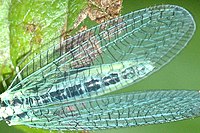Chrysopa perla
| Chrysopa perla | |
|---|---|

| |
| Near Havelsee, Germany | |
| Scientific classification | |
| Domain: | Eukaryota |
| Kingdom: | Animalia |
| Phylum: | Arthropoda |
| Class: | Insecta |
| Order: | Neuroptera |
| Family: | Chrysopidae |
| Genus: | Chrysopa |
| Species: | C. perla
|
| Binomial name | |
| Chrysopa perla | |
| Synonyms[1] | |
|
List
| |
Chrysopa perla, the Pearly Green Lacewing,[2] is an insect species belonging to the green lacewing family, Chrysopidae (subfamily Chrysopinae).
Distribution[edit]
This widespread species is present in most of Europe[3] and in temperate zones of Asia.[4][5]
Habitat[edit]
These insects prefer cool and shady areas, mainly in deciduous woods, wet forests, woodland edges, hedge rows, scrubby grassland and shrubs.[6][4]
Description[edit]
The adults reach 10–12 millimetres (0.39–0.47 in) of length, with a wingspan of 25–30 millimetres (0.98–1.18 in).[5][6] The basic coloration of the body is green. Wings are blue-green with black veins. They turn pale yellow during the winter. Several black markings are present on the head, the thorax and below the abdomen.[5] The second antennal segment is black.[4] This species is rather similar to Chrysopa dorsalis, showing an oval pale spot between the eyes, which is roundish in C. perla.[4]
Biology[edit]
Adults can be encountered from May through August.[6] They are fearsome predators, primarily feeding on aphids,[5] occasionally on flower nectar.[4]
The females usually lay eggs near aphid colonies.[5] Larvae are predators, mainly feeding on Aphididae, Coccidae species and caterpillars (Pieris brassicae, Autographa gamma).[6] The adult insects hibernate in winter.[5]
Gallery[edit]
-
Dorsal view
-
Female. Side view
-
Wing detail
-
Eating aphids
-
Video clip
References[edit]
- ^ Catalogue of the world
- ^ "Pearly Green Lacewing". Landscape Britain. Retrieved 2023-03-13.
- ^ Fauna europaea
- ^ a b c d e Nature Spot
- ^ a b c d e f Insektenbox (in German)
- ^ a b c d J.K. Lindsey Commanster Archived 2018-10-09 at the Wayback Machine
Further reading[edit]
- Chrysopa perla p. 417 in Hagen, K.S; Mills, N.J; Gordh, G; McMurtry, J.A (1999). "Terrestrial Arthropod Predators of Insect and Mite Pests". In Bellows, Thomas S.; Fisher, T.W. (eds.). Handbook of Biological Control. pp. 383–503. doi:10.1016/B978-012257305-7/50063-1. ISBN 978-0-12-257305-7.
- Plant, Colin W. (1994). Provisional atlas of the lacewings and allied insects (Neuroptera, Megaloptera, Raphidioptera and Mecoptera) of Britain and Ireland. ISBN 978-1-870393-18-8.
- Flint, H. M; Salter, S. S; Walters, S (1979). "Caryophyllene: An Attractant for the Green Lacewing". Environmental Entomology. 8 (6): 1123–1125. doi:10.1093/ee/8.6.1123.
- James, David G (2003). "Field Evaluation of Herbivore-Induced Plant Volatiles as Attractants for Beneficial Insects: Methyl Salicylate and the Green Lacewing, Chrysopa nigricornis". Journal of Chemical Ecology. 29 (7): 1601–1609. doi:10.1023/A:1024270713493. PMID 12921438.
- Bond, Alan B (1980). "Optimal foraging in a uniform habitat: The search mechanism of the green lacewing". Animal Behaviour. 28: 10–19. doi:10.1016/S0003-3472(80)80003-0.
- Romeis, Jörg; Dutton, Anna; Bigler, Franz (2004). "Bacillus thuringiensis toxin (Cry1Ab) has no direct effect on larvae of the green lacewing Chrysoperla carnea (Stephens) (Neuroptera: Chrysopidae)". Journal of Insect Physiology. 50 (2–3): 175–183. doi:10.1016/j.jinsphys.2003.11.004. PMID 15019519.
- Knowledge Encyclopedia Animal!. Dorling Kindersley. 2016-10-03. p. 45. ISBN 978-0-241-28964-8.
External links[edit]
- Uniprot
 Media related to Chrysopa perla at Wikimedia Commons
Media related to Chrysopa perla at Wikimedia Commons Data related to Chrysopa perla at Wikispecies
Data related to Chrysopa perla at Wikispecies




